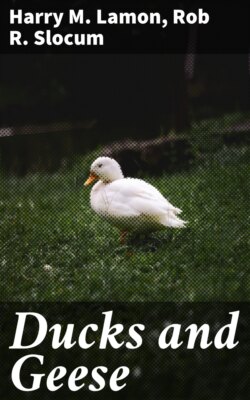Читать книгу Ducks and Geese - Rob R. Slocum - Страница 12
На сайте Литреса книга снята с продажи.
Egg Production
ОглавлениеWhile the conditions under which ducks are kept and the care they are given will affect their egg production greatly, there are certain rather definite comparisons that can be made between the different breeds. The Pekin is a good layer and will produce from 80 to 120 eggs. The Aylesbury and the Rouen are about alike in laying ability, neither being quite as good as the Pekin. The Cayuga is a good layer ranking with the Aylesbury and Rouen or between these and the Pekin. The Muscovy is an excellent layer being fully as prolific as the Pekin, especially if broken up when broody and not allowed to sit. The Blue Swedish is about equal to the Cayuga in laying ability. The Buff duck is an excellent layer comparing favorably with the Pekin or even with the Runner. The Runner ducks are the best layers of the duck family and if given proper care and good feed will compare favorably with hens in egg producing ability. The Crested White duck is not a particularly good layer. The Calls and the Black East India ducks will lay from 20 to 60 eggs per year, approaching the latter number if the eggs are collected as laid and the ducks are not allowed to sit which will induce some of them to continue to lay for quite a portion of the year. Extremely large ducks of any breed do not lay as well as the more medium sized birds.
Size of Duck Eggs. The eggs of the different meat breeds will run about the same in size with the exception of the Muscovy whose eggs run a little larger. Actual weights of eggs from representative flocks show Pekin, Rouen, Aylesbury and Cayuga eggs to average about 2½ pounds per dozen although there is a tendency for the Rouen eggs to run somewhat larger and for Cayugas to run a little smaller. Muscovy eggs weigh about 3 pounds per dozen with selected large eggs weighing as high as 3¼ pounds. Eggs of the Runner duck are smaller but are considerably larger than average hens' eggs or about the size of large Minorca eggs. They weigh about 2 pounds per dozen. Eggs of the bantam breeds of ducks, the Calls and the Black East India, together with those of the Mandarin and Wood ducks will weigh from one pound to 1½ pounds per dozen depending upon the size of the ducks themselves. Eggs of the Mallard duck will run from 26 to 32 ounces to the dozen. The size of eggs laid by ducks, especially the bantam breeds and the Mallard can be increased somewhat by liberal feeding. Average hens' eggs should weigh about 1½ pounds per dozen.
Fig. 3. Upper—Comparison of size of goose egg on the left a black egg of a Cayuga duck in the center and a hen egg on the right. Lower—Duck eggs—At the left is a Pekin duck egg, next a black egg laid by a Cayuga duck, third a Muscovy egg, fourth a duck egg of green color and on the extreme right the egg of a Runner duck. (Photographs from the Bureau of Animal Industry, U. S. Department of Agriculture.)
Color of Eggs. The color of duck eggs ranges from white to a polished black. Pekin eggs run mostly white although some show a decided blue or green tint. Aylesbury eggs run quite uniformly white. The color of Rouen eggs varies from white to a dark green. The Cayuga produces very few white eggs, most of them being green or black, some being as black as though polished. Muscovy eggs run from a white to a greenish cream in color. The eggs of the Blue Swedish and the Buff ducks usually run white. The Runner duck lays white eggs as a rule while the Crested White duck lays eggs which range in color from white to green. The eggs of the Call ducks run from white to green while the eggs of the Black East India, like the Cayuga, for the most part run from green to black.
A peculiarity in regard to the egg color is that the same female may lay eggs which are widely different in color. It is likewise true that the color of the shell is influenced to some extent by the feed. Ducks on range will lay darker colored eggs than those which are yarded. There is also a tendency for the eggs to run darker in color when laying first begins and for the eggs to lighten as laying proceeds. A peculiarity in regard to duck eggs with a dark colored shell is that a thorough washing will lighten up the shell color decidedly.
Broodiness. The Muscovy, the Call and the Black East India ducks are broody breeds. The ducks of these breeds will make their nests, hatch their eggs and are good mothers. All the other breeds are classed as non-broody breeds. Of course, a certain percentage of them will go broody and show a desire to sit but they do not make reliable sitters and mothers and are not as a rule used for this purpose.
